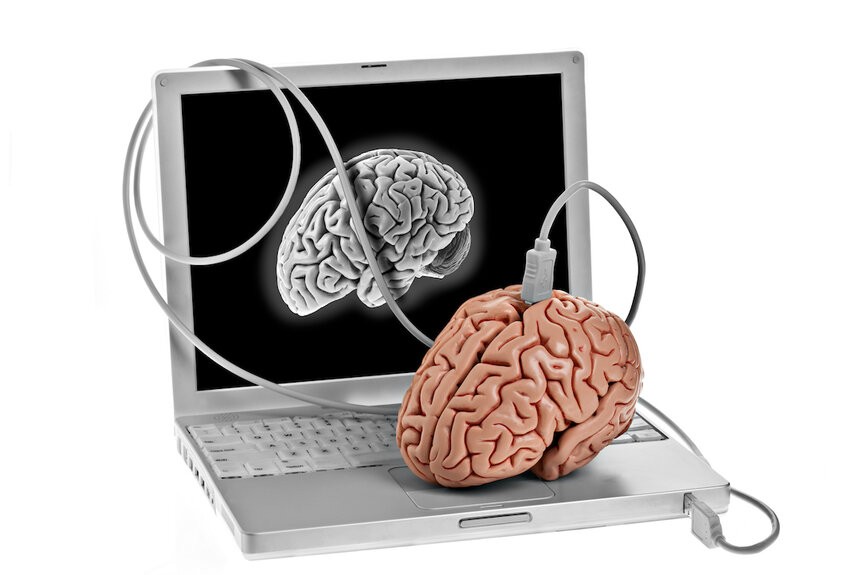Create a free profile to get unlimited access to exclusive videos, sweepstakes, and more!
'Organoid intelligence' could lead to computers powered by the human brain
Just put your brain directly inside the screen. Thanks.

The 1992 science fiction film The Lawnmower Man follows a neuroscientist named Lawrence Angelo (Pierce Brosnan) as he begins experiments on an unassuming gardener named Jobe (Jeff Fahey). The experiments are intended to increase human intelligence using a combination of nootropic drugs and emerging virtual reality. Unbeknownst to Dr. Angelo, the organization funding the research swapped out the drug cocktail to one which also causes increased aggression. All the better for making super-smart, super-deadly soldiers. The result is a hyper-intelligent and ultra-aggressive Jobe — did we mention he also developed telekinesis? — seeking revenge on everyone who ever wronged him. By the end of the first film, the titular Lawnmower Man transforms into a fully digital being, existing in cyberspace.
The sequel, Lawnmower Man 2: Beyond Cyberspace (streaming now on Peacock!) picks up years later, in a dystopian cyberpunk future. A new computer chip, powerful enough to control entire civilizations, is about to be unleashed upon the world and Jobe might be the only person, such as he is, who can save us.
RELATED: Connecting mind to machine: the science behind 'RoboCop'
Jobe succeeds, either as a villain or a hero, thanks to the combination of biology and technology at his disposal. Once that connection is severed, he reverts to the mundane person he was before this whole wacky story started. He got worse at a whole bunch of things, like controlling things with his mind, and better at other things, like not being a homicidal semi-digital maniac. There’s a give and take with technology in Jobe’s fictional world just like there is in the real world.
The brain is a biological thinking machine unlike anything our engineers have been able to invent. While synthetic computers are good at quick calculations, brains excel in creativity and breadth. Organisms are moderately good at a whole lot of things while computers are exceedingly good at very specific things. A computer, for instance, might be able to calculate Pi to 63 trillion digits, but they struggle to know how many fingers the average person has. To really get weird, we’re going to need machines with the analytical ability of modern computers and flexibility of creatures forged through four billion years of biological battle royale.
Today’s scientists are working hard to bridge the gap between what biology and technology are capable of to create something new with the benefits of both, and they’re able to do it thanks to miniature brain-like things they grow in the lab. These collections of brain cells about the size of a pen dot are called organoids, and they’re allowing scientists to do all sorts of things they couldn’t do a couple of decades ago.
Recently, an international team of scientists, led by researchers at Johns Hopkins University, outlined a plan for the development of a multidisciplinary field of “organoid intelligence.” The study was published in the journal Frontiers in Science.
Unlike cells grown in a petri dish, which spread out in a flat, two-dimensional sheet, organoids grow in three dimensions and develop neuronal connections between cells. Some have even managed to grow eye-like organs on their surfaces. These three-dimensional structures are more complex and more closely mirror the real deal huddled inside your skull. That makes them good for researching things like neurological disease, but it also makes them good for running computers.
In an unrelated study, researchers used living brain tissue, a so-called “brain on a chip,” to play Pong. Importantly, scientists didn’t teach the brain-chip how to play the game. Instead, they set it loose and allowed it to learn through experience. After just a few minutes it had already started to learn and got better with time. It’s that ability to encounter a previously unknown scenario and learn how to handle it that makes the potential of organoid intelligence so exciting.
RELATED: Mindless gaming! Brain cells in petri dish learn to play Pong
Current supercomputers are capable of operating at levels comparable to the brain of a mouse, but only briefly and with incredible energy costs. Scientists believe that over the next decade or so, the incorporation of organoids into computer systems could result in machines that learn continuously, make faster decisions, and are orders of magnitude more energy efficient.
While a single organoid might not have the power or capability of a full-fledged human brain, researchers envision complex networks of interconnected brain organoids, sensors, and outputs. Moreover, they envision creating other sensory organoids like the aforementioned organoid eyes, to increase the intelligence and functionality of our cyborg computers.
Of course, there are some unavoidable ethical concerns which need to be addressed, particularly as our ability to create more complex organoids continues to develop. That’s why the paper emphasizes the need to incorporate an ethics-based approach as we move forward. We don’t yet have a solid understanding of when and how consciousness emerges in a brain or brain-like organ and the last thing we want is to trap some bodyless persons inside a next-generation ATM machine or something. Brain organoids could help us to solve those sorts of questions and better understand the workings of our own minds, all while helping us to build better machines, but we should make sure not to become monsters in the process.
We like our monsters like we like our popcorn: at the movies. See what happens when technology goes horribly wrong in Lawnmower Man 2, streaming now on Peacock!



























